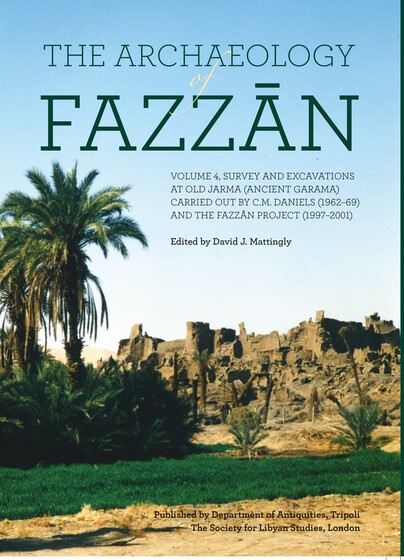
Format: Hardback
Pages: 700
ISBN: 9781900971188
Pub Date: 31 Aug 2013
Imprint: Society for Libyan Studies
Series: Society for Libyan Studies Monograph
Description:
This is the concluding volume of the Archaeology of Fazzān series, bringing to press the combined results of two Anglo-Libyan projects in southern Libya: the pioneering work of Charles Daniels between 1958 and 1977 and the Fazzān Project directed by David Mattingly between 1997 and 2001. The investigations carried out by these two projects allow an entirely new reconstruction and understanding of the historic desert societies of the Libyan Sahara. In particular, the work has shed light on the ancient people known to Greco-Roman writers as the Garamantes, who are now revealed to have been a sophisticated state, with permanent towns and villages and an economy based on oasis agriculture and Saharan trade.
This volume presents the results of excavations and survey work at the site of Old Jarma, identifiable with the Garamantian capital, Garama, that also had a long after-life in Medieval and Early Modern times. The Fazzān Project revealed an extraordinary urban story, spanning 10 major construction phases that extended from c.400 BC to the AD 1930s. The detailed publication of the complex stratigraphic evidence and the accompanying finds assemblages opens a fascinating window on the cultural heritage and lifeways of a central Saharan oasis.

Format: Paperback
Pages: 221
ISBN: 9788073084448
Pub Date: 31 Jul 2013
Description:
The book includes contributions of the following authors: Hartwig Altenmüller, Ladislav Bareš, Miroslav Bárta, Andreas Effland, Martin Fitzenreiter, Hans Goedicke, Peter Jánosi, Dieter Kurth, Christian Loeben, Juan Carlos Moreno García, Jana Mynářová, Anthony Spalinger, Miroslav Verner, Hana Vymazalová, Wolfgang Waitkus.
Making and Breaking the Gods
Christian Responses to Pagan Sculpture in Late Antiquity
Format: Hardback
Pages: 350
ISBN: 9788771240894
Pub Date: 31 Jul 2013
Description:
Drawing on both textual and archaeological sources, this book discusses how Christians in Late Antiquity negotiated the sculptural environment of cities and sanctuaries in a variety of ways, ranging from creative transformations to iconoclastic performances. Their responses to pagan sculpture present a rich window into the mechanisms through which society and culture changed under the influence of Christianity. The book thus demonstrates how Christian responses to pagan sculpture rhetorically continued an old tradition of discussing visual practices and the materiality of divine representations.
Focusing in particular on the Egypt and the Near East, it furthermore argues that Christian responses encompass much more than mindless violence and need to be contextualised against other social and political developments, as well as local traditions of representation.
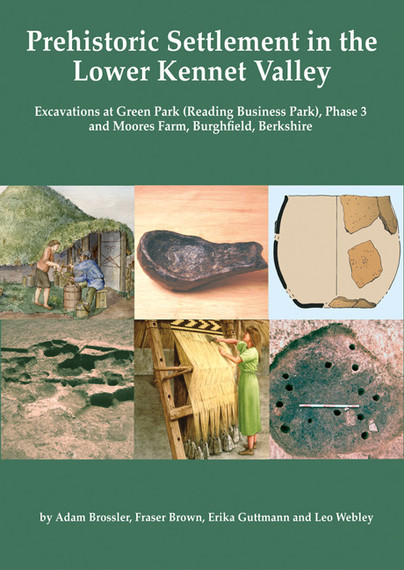
Format: Paperback
Pages: 150
ISBN: 9781905905294
Pub Date: 31 Jul 2013
Series: Thames Valley Landscapes Monograph
Description:
This volume presents the results of two excavations on the gravel terraces of the Lower Kennet Valley, at Green Park (Reading Business Park) Phase 3 and Moores Farm, Burghfield, Berkshire.The Green Park excavations uncovered a field system and occupation features dating to the middle to late Bronze Age. Five waterholes or wells were distributed across the field system, the waterlogged fills of which preserved wooden revetment structures and valuable environmental evidence.
The pottery from the waterholes makes a significant contribution to our understanding of the middle to late Bronze Age transition in the region. Later activity included middle to late Iron Age boundaries, a late Iron Age cremation burial, a Romano-British field system and post-medieval trackways.The Moores Farm excavations revealed occupation from the Mesolithic, Neolithic, middle Bronze Age and early Iron Age. The middle Bronze Age settlement included pits, ovens and possible post structures, and was again situated within a contemporaneous field system dotted with waterholes.As well as discussing these two sites, the volume provides an overview of all of the work to date in the Green Park Farm/Reading Business Park area, exploring the development of this important prehistoric landscape.
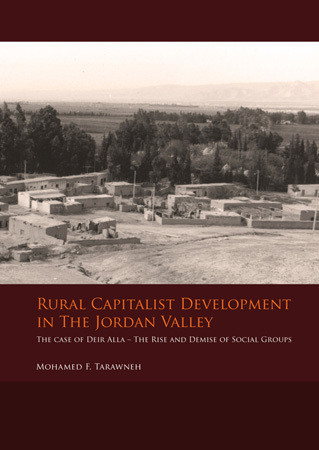
Format: Paperback
Pages: 116
ISBN: 9789088900891
Pub Date: 31 Jul 2013
Description:
The case of Deir Alla is a social and economic case study of developing Third World agriculture. The study is based upon historical sources, contemporary public information with statistics, and field work in the Jordanian village of Deir Alla. This fieldwork took place in 1986 and a report was prepared in 1989.
For this publication additional field work in 1997 accounted for the rapidly changing social and economic situation.The Ottoman feudal system, with the local harrath (ploughman) economy, changed gradually to private ownership since 1936, affecting the social relations of production. From 1950 onwards this development was strongly influenced by a sudden population increase (Palestinian refugees), the East Ghor irrigation system, the strong promotion of vegetable production and new technologies and institutions. Share cropping became the dominant feature of agrarian relations, but during the last decades international migrant labour expanded the wage labour system.Some types of production organization, such as the small-owner-family-labour system, proved to be more successful than others, but with the current difficult economic situation the debt trap is felt by many of these small owners.The book is important for the understanding of the social and economic history of the region, showing the dynamics of social change, but also because of its thorough analysis of the current situation, assessing theoretical models and predicting developments in a rapidly changing agricultural world.Mohamed Fayez Tarawneh is Associate Professor at Yarmouk University, specialized in the Anthropology of development and particularly interested in rural development and social change. Furthermore, he is the general manager of the Hashemite Fund for the Development of Jordan Badia. Some of his major publications concern a historical and social geographic study of the Jordanian town and countryside of Kerak, the participatory development in Wadi Araba and Poverty in Jordan.
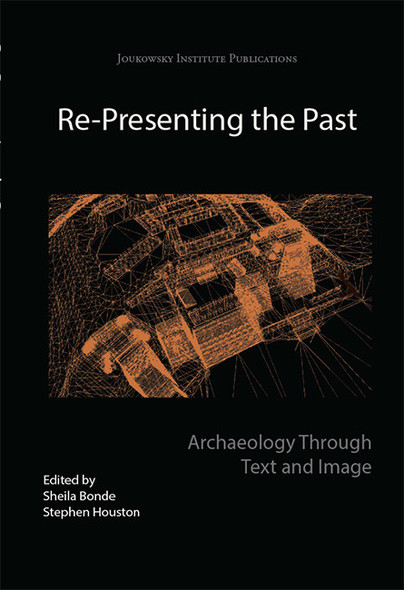
Format: Paperback
Pages: 215
ISBN: 9781782972310
Pub Date: 01 Jul 2013
Series: Joukowsky Institute Publication
Illustrations: 46 b/w figs, 12 col figs
Description:
The archaeological past exists for us through intermediaries. Some are written works, descriptions, narratives and field notes, while others are visual: the drawings, paintings, photographs, powerpoints or computer visualizations that allow us to re-present past forms of human existence. This volume brings together nine papers, six of which were presented at a symposium hosted at Brown University.
Two papers explore the classical past and medieval visualizations. Three treat the Maya, and one considers the imaging by eighteenth-century antiquarians of British history; yet another ranges broadly in its historical considerations. Several consider the trajectory over time of visualization and self-imaging. Others engage with issues of recording by looking, for example, at the ways in which nineteenth–century excavation photographs can aid in the reconstruction of an inscription or by evaluating the process of mapping a site with ArcGIS and computer animation software. All essays raise key questions about the function of re-presentations of the past in current archaeological practice.
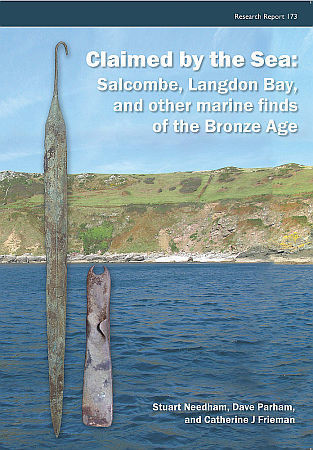
Format: Paperback
Pages: 240
ISBN: 9781902771953
Pub Date: 30 Jun 2013
Description:
First discovered by sport divers in the 1970s, the two remarkable seabed finds of prehistoric bronze metalwork described here quickly became a testing ground for the new discipline of underwater archaeology, initially under the leadership of the pioneering maritime archaeologist Keith Muckelroy. A haul of 361 bronzes from Langdon Bay, Kent, represents one of the largest deposits from Bronze Age Europe. Dating to the thirteenth century BC, the collection is diverse in character and originates in various parts of western Europe and the British Isles.
The assemblage from Salcombe, Devon covered here is of similar date with a unique combination of types and materials; further finds have since been made at this site.Neither site having yielded any ship’s remains, all possible mechanisms for deposition are reviewed, including erosion of coastal deposits and ritual deposition at sea. Extensive comparative analysis favours the conclusion that the unparalleled Langdon Bay and Salcombe assemblages represent material spilled or jettisoned from boats in trouble.For the first time, maritime archaeologists, period specialists, scientists and coastal geomorphologists, bring together research on these two exceptional sites: history of discovery, evaluation of context and character, detailed scientific analyses and a fully illustrated catalogue. Nineteen further marine finds of Bronze Age metalwork are also documented, models for seaborne exchange are reconsidered and cultural attitudes to the terre/mare interface are discussed.
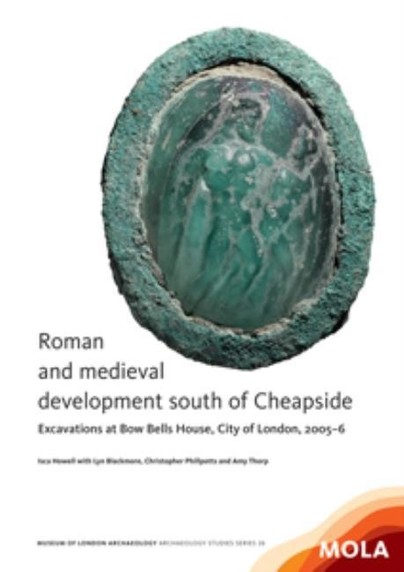
Format: Paperback
Pages: 120
ISBN: 9781907586170
Pub Date: 30 Jun 2013
Series: MoLAS Archaeology Studies Series
Description:
Excavations on the south side of Cheapside found evidence for Roman timber buildings and pits dating to the later 1st and 2nd centuries AD, and a masonry building constructed after c AD 125. The main west–east road through Londinium lay immediately north of the site. Evidence for later Roman occupation was limited by modern truncation.
No medieval ground surfaces survive, but the site was reoccupied from the 10th century with at least one substantial building existing by the 13th century. Pit and well groups include late 13th- or early 14th-century vessels associated with the wine trade and early 14th-century kitchenware.
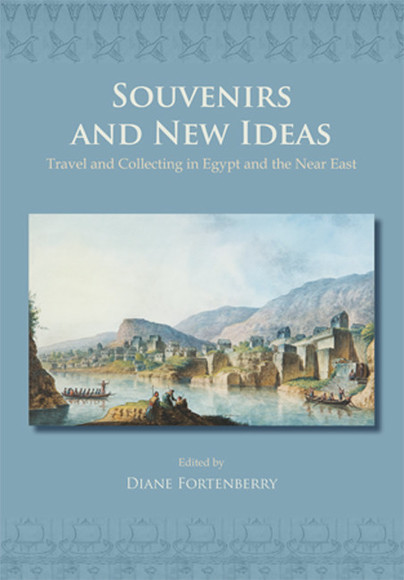
Format: Paperback
Pages: 200
ISBN: 9781842178157
Pub Date: 30 Jun 2013
Series: ASTENE Publications
Description:
During the 18th and 19th centuries, many travellers aimed to record their travels through Egypt, Mesopotamia, the Levant and Turkey by collecting souvenirs and mementos of places they had visited. This natural inclination took many different guises: from innocent activities such as making diaries and sketches, gathering academic knowledge or taking photographs, to acquiring souvenirs, very often antiquities. Other, more unscrupulous, travellers undertook journeys specifically to ‘collect’ antiquities to form the basis of museum collections or to profit by re-selling them.
Souvenirs and New Ideas explores the human desire to retain the memory of a journey by ‘collecting objects’ with a series of essays examining the motivation of a variety of different travellers ranging from intrepid female solo travellers to European royalty. The acquisitions of these individuals ranged from tales of folklore and academic knowledge to the wholesale looting of Egyptian antiquities. Although the habit of ‘collecting antiquities’ is deplored and condemned today, this volume sheds light on the attitudes behind the practice and seeks to strengthen our current beliefs about the value of cultural patrimony.

Format: Paperback
Pages: 196
ISBN: 9780856688607
Pub Date: 03 Jun 2013
Series: ACE Studies
Description:
Scenes from the Old Kingdom tombs represent our main sources for the study of daily life of private individuals. Written by a number of specialists with years of research, this monograph deals with various aspects of life in ancient Egypt, presented in an accessible manner to the scholar and lay-person alike. Richly illustrated with an excellent selection of photographs and drawings, the book aims to bring the reader as close as possible to the Egyptian sources, allowing them to delve into the world behind the scenes.
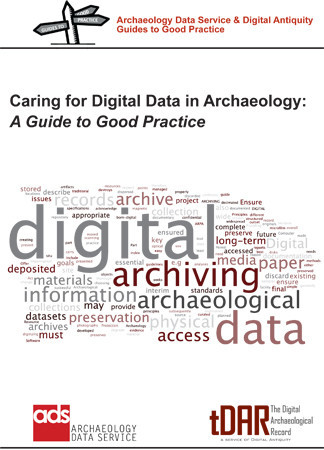
Format: Paperback
Pages: 122
ISBN: 9781782972495
Pub Date: 31 May 2013
Illustrations: b/w illustrations, 1 col.
Description:
A wide variety of organizations are both creating and retaining digital data from archaeological projects. While current methods for preservation and access to data vary widely, nearly all of these organizations agree that careful management of digital archaeological resources is an important aspect of responsible archaeological stewardship. The Archaeology Data Service and Digital Antiquity have produced this guide to provide information on the best way to create, manage, and document digital data files produced during the course of an archaeological project.
This guide aims to improve the practice of depositing and preserving digital information safely within an archive for future use and is structured in three main parts: Digital Archiving - looks at the fundamentals of digital preservation and covers general preservation themes within the context of archaeological investigations, research, and resource management, with an overview of digital archiving practice and guidance. The Project Life cycle - looks at common project life cycle elements such as file naming, meta-data creation, and copyright and covers general, broad themes that should be considered at the outset of a project. Basic Components - looks at selected technique and file type-specific issues together with archive structuring and deposit. This section covers common file types that are frequently present in archaeological archives, irrespective of a project's primary technique or focus. The accompanying online Guides to Good Practice take these elements further and address the preservation of data resulting from common data collection, processing and analysis techniques such as aerial and geophysical survey, laser scanning, GIS and CAD.
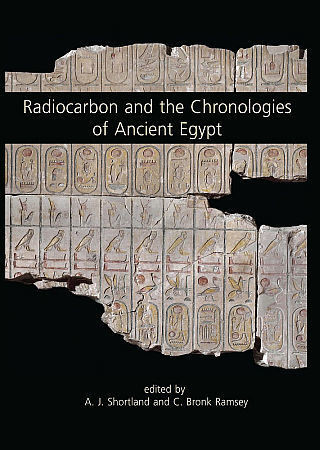
Format: Paperback
Pages: 192
ISBN: 9781842175224
Pub Date: 31 May 2013
Illustrations: 80 b/w + col illus.
Description:
This volume presents the findings of a major international project on the application of radiocarbon dating to the Egyptian historical chronology. Researchers from the Universities of Oxford and Cranfield in the UK, along with a team from France, Austria and Israel, radiocarbon dated more than 200 Egyptian objects made from plant material from museum collections from all over the world. The results comprise an accurate scientifically based chronology of the kings of ancient Egypt obtained by the radiocarbon analysis of short-lived plant remains.
The research sheds light on one of the most important periods of Egyptian history documenting the various rulers of Egypt's Old, Middle and New Kingdoms. Despite Egypt's historical significance, in the past the dating of events has been a contentious undertaking with Egyptologists relying on various chronologies made up from archaeological and historical records. The radiocarbon dates nail down a chronology that is broadly in line with previous estimates. However, they do rule out some chronologies that have been put forward particularly in the Old Kingdom, which is shown to be older than some scholars thought. The research has implications for the whole region because the Egyptian chronology anchors the timing of historical events in neighbouring areas tied to the reign of particular Egyptian kings. The results will allow for more historical comparisons to be made in countries like Libya and Sudan, which have conducted radiocarbon dating techniques on places of archaeological interest in the past.
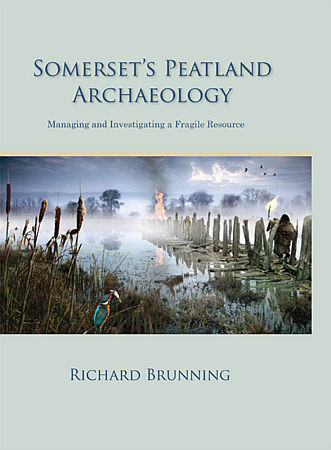
Format: Hardback
Pages: 352
ISBN: 9781842174883
Pub Date: 31 May 2013
Illustrations: b/w & colour illus
Description:
The Somerset Levels and Moors are part of a series of coastal floodplains that fringe both sides of the Severn Estuary. These areas have similar Holocene environmental histories and contain a wealth of waterlogged archaeological landscapes and discrete monuments. The importance of Somerset's prehistoric wetland heritage is shown by the fact that twenty-five percent of all the prehistoric waterlogged sites thought still to exist in England are from the Somerset moors, the County Museum in Taunton Castle holds the largest collection of conserved prehistoric worked wood in the UK, possibly in the whole of Europe, the Sweet Track (the oldest known wooden trackway in the UK) and Glastonbury Lake Village have produced the most complete record of Neolithic and Iron Age material culture in the UK and Glastonbury Lake Village was the best preserved prehistoric settlement ever discovered in the UK.
This substantial monograph presents the results of the MARISP project ( Monuments at Risk in Somerset Peatlands) which thoroughly assessed the condition of the wetland monuments and the ongoing threats to their survival and aimed to answer key research questions about the sites through the use of minimally invasive excavation and to inform the development of future national and county wetland strategies.

Format: Hardback
Pages: 240
ISBN: 9781842174739
Pub Date: 03 May 2013
Series: Levant Supplementary Series
Description:
The Jordanian badia is an arid region that has been largely protected from modern development by its extreme climate and has preserved a remarkably rich record of its prehistoric past. This is the second of two volumes to document extensive surveys and excavations in the region from Al-Azraq to the Iraqi border over the period 1979-1996. Broadly, it covers the Late Neolithic and Chalcolithic of the eastern badia.
Over time, an outline prehistory of the region has emerged. Late Epipaleolithic campsites have been found in the north-west of the harra in the foothills of Jebel Druze, while the central basalt region saw a floruit of activity in the late Aceramic Neolithic, when it was used extensively for hunting. This volume covers the following period, which witnessed a further spread of campsites and short-term occupation out around the edges of the harra and across the hamad as far as the lands bordering the Euphrates to the north and east. This period was marked by the first appearance of sheep and goat as one element of the steppic economy alongside traditional practices of hunting and foraging. The concluding chapter discusses these changes and proposes models for the introduction of domesticated animals into the steppe as a precursor to a full nomadic pastoral economy.

Format: Hardback
Pages: 320
ISBN: 9781842175187
Pub Date: 03 May 2013
Illustrations: 260 col illus.
Description:
The region of Rough Cilicia (modern area the south-western coastal area of Turkey), known in antiquity as Cilicia Tracheia, constitutes the western part of the larger area of Cilicia. It is characterised by the ruggedness of its territory and the protection afforded by the high mountains combined with the rugged seacoast fostered the prolific piracy that developed in the late Hellenistic period, bringing much notoriety to the area. It was also known as a source of timber, primarily for shipbuilding.
The twenty-two papers presented here give a useful overview on current research on Rough Cilicia, from the Bronze Age to the Byzantine period, with a variety of methods, from surveys to excavations. The first two articles (Yağcı, Jasink and Bombardieri), deal with the Bronze and Iron Ages, and refer to the questions of colonisation, influences, and relations. The following four articles (Tempesta, de Souza, Tomaschitz, Rauh et al.) concern the pirates of Cilicia and Isauria who were a big problem, not only for the region but throughout the Mediterranean and Aegean during the late Hellenistic and especially Roman periods. Approaching the subject of Roman Architecture, Borgia recalls Antiochus IV of Commagene, a king with good relations to Rome. Six papers (Spanu, Townsend, Giobbe, Hoff, Winterstein, and Wandsnider) publish work on Roman architecture: architectural decoration, council houses, Roman temples, bath architecture, cenotaph, and public buildings. Ceramics is not neglected and Lund provides a special emphasis on ceramics to demonstrate how pottery can be used as evidence for connections between Rough Cilicia and northwestern Cyprus. Six contributions (Varinliog(lu, Ferrazzoli, Jackson, Elton, Canevello and Özy?ld?r?m, Honey) deal with the Early Christian and Byzantine periods and cover rural habitat, trade, the Kilise Tepe settlement, late Roman churches, Seleucia, and the miracles of Thekla. The final article (Huber) gives insight into methods applied to the study of architectural monuments.

Format: Paperback
Pages: 280
ISBN: 9789088901089
Pub Date: 30 Apr 2013
Illustrations: 50 fc, 100 b/w illus
Description:
Europe is dotted with tens of thousands of prehistoric barrows. In spite of their ubiquity, little is known on the role they had in pre- and protohistoric landscapes. In 2010, an international group of archaeologists came together at the conference of the European Association of Archaeologists in The Hague to discuss and review current research on this topic.
This book presents the proceedings of that session.The focus is on the prehistory of Scandinavia and the Low Countries, but also includes an excursion to huge prehistoric mounds in the southeast of North America. One contribution presents new evidence on how the immediate environment of Neolithic Funnel Beaker (TRB) culture megaliths was ordered, another one discusses the role of remarkable single and double post alignments around Bronze and Iron Age burial mounds. Zooming out, several chapters deal with the place of barrows in the broader landscape. The significance of humanly-managed heath in relation to barrow groups is discussed, and one contribution emphasizes how barrow orderings not only reflect spatial organization, but are also important as conceptual anchors structuring prehistoric perception. Other authors, dealing with Early Neolithic persistent places and with Late Bronze Age/Early Iron Age urnfields, argue that we should also look beyond monumentality in order to understand long-term use of “ritual landscapes”.The book contains an important contribution by the well-known Swedish archaeologist Tore Artelius on how Bronze Age barrows were structurally re-used by pre-Christian Vikings. This is his last article, written briefly before his death. This book is dedicated to his memory.This publication is part of the Ancestral Mounds Research Project of the University of Leiden.
















